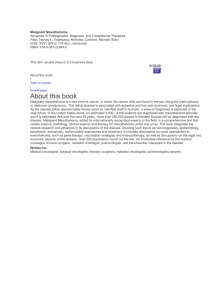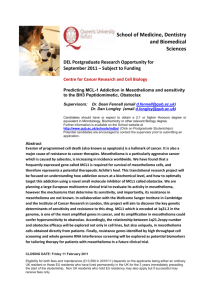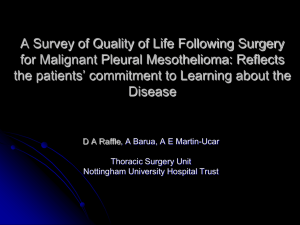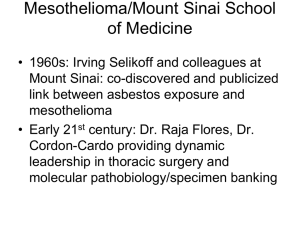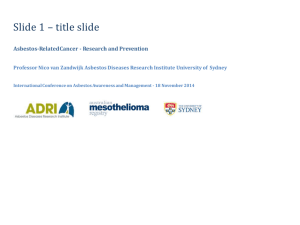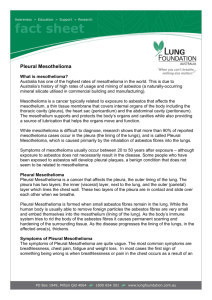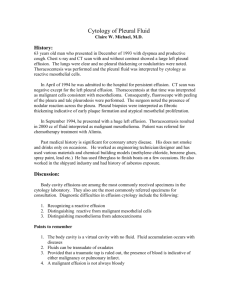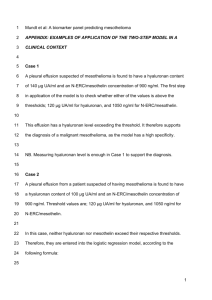National Asbestos Forum 2013: Advance in Medical Research on
advertisement
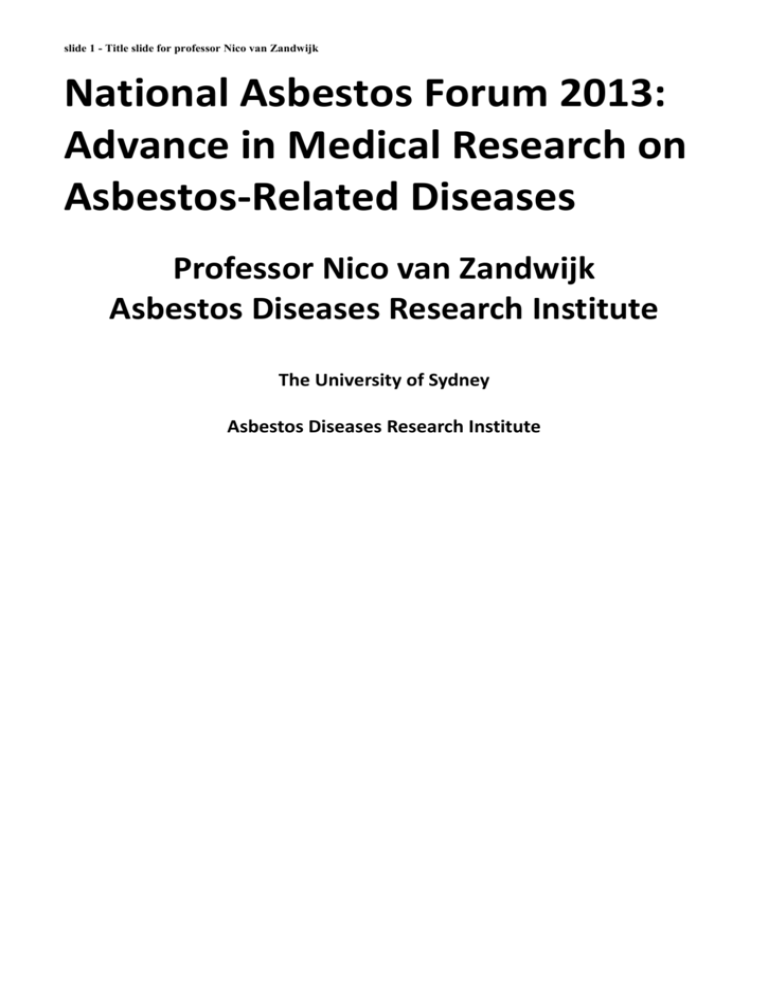
slide 1 - Title slide for professor Nico van Zandwijk National Asbestos Forum 2013: Advance in Medical Research on Asbestos-Related Diseases Professor Nico van Zandwijk Asbestos Diseases Research Institute The University of Sydney Asbestos Diseases Research Institute slide 2 Content • List of Asbestos-Related Diseases • Epidemiology of Asbestos-Related Diseases • State of the Art for Diagnosis and Treatment of Malignant Pleural Mesothelioma • Unraveling the Genetic Codes of Cancer • Importance of Disease Markers and Individualization of Therapy • Research into Novel (targets for) Treatments for Asbestos-Related Diseases • Patient Interviews & Models of Care slide 3 Asbestos-Related Diseases • • • • Asbestosis Pleural Plaques, Pleural Thickening, Pleural Effusion Malignant Mesothelioma Lung Cancer: two cases for every case of Malignant Mesothelioma • Laryngeal Cancer (area of the voice box) • Ovarian Cancer • Australia > 2000 cases/year (difficult to verify those Lung Cancer cases caused by Asbestos exposure) slide 4 Combined Effects Tobacco and Asbestos Is there a relationship between excess lung cancer risk and the combination of smoking and asbestos exposure? slide 5 Guidelines for Diagnosis and Treatment of Malignant Pleural Mesothelioma 2013 • Written for health practitioners • Consumer version available in early 2014 • 47 experts (including patients, family members) • Based on the best evidence • Patient centered / “Primum non Nocere” • 18,371 references (publications) were checked • 2304 full text references reviewed • 1118 references were relevant and scored • Approved by NHMRC (2-July 2013) slide 6 ADRI Guidelines for the Diagnosis and Treatment of Malignant Pleural Mesothelioma Guidelines available through ADRI website www.adri.org.au hard copy or USB stick available today at the reception desk of the 2013 National Asbestos Forum slide 7 Epidemiology (study of patterns, causes, of disease conditions in defined populations) of Asbestos-Related Diseases • Number of Asbestosis patients positively affected by preventative measures • Clear effect of preventative measures on the incidence of Malignant Mesothelioma is yet to be seen (Australia) • Changing face of Malignant Mesothelioma? – Data from Western Australia – Early data from the Australian Mesothelioma Registry • Occupational exposure to white asbestos is associated with a very high risk of Lung Cancer (China) slide 8 Changing Face of Malignant Mesothelioma? • Wall Street Journal of 18-6-2013, 2 page article • Head & Neck Surgeon, who died from Malignant Mesothelioma • Limited exposure to asbestos (cleaning a boiler) as a boy Malignant Mesothelioma attributed to Home Renovation The potential Hazard of Asbestos in the Built Environment Between 1945 and 1960, 25% of all homes in Australia were clad in asbestos cement. Home renovation is a popular activity in Australia. slide 9 has not been included as it only has 2 images that did not have any bearing on this accessible version of the presentation slide 10 Possible Shifts in Type of Asbestos Exposure in Western Australia There is evidence that an increasing number of mesothelioma cases were non-occupationally exposed (Olsen et al, 2012) Reference: OLSEN ET AL,MJA 2011 slide 11 Malignant Mesothelioma attributed to Home Renovation Reference: OLSEN ET AL,MJA 2011 slide 12 Possible Shifts in Type of Asbestos Exposure in Australia, Pilot Data Exposure data on 86 mesothelioma cases in 2011 was analysed Reference: Australian Institute of Health and Welfare, Cancer Survival and Prevalence in Australia, 2012 slide 13 What is the Australian Mesothelioma Registry (AMR)? Stand alone database of all mesothelioma cases diagnosed in Australia from 1-7-2010 Better understand the exact relationship between asbestos exposure and mesothelioma (nature and levels of asbestos exposure that can result in mesothelioma) Identify workers (and others) that may be exposed to potentially dangerous levels of asbestos and prevent that exposure Assist in the development of policies to best deal with asbestos still present in our environment Provide information to assist researchers in undertaking investigations with the aim of preventing mesothelioma in the future slide 14 Malignant Mesothelioma: Diagnosis, Prognosis and Prediction of Effect of Therapy • Diagnosis difficult (expertise of the medical team) • Poor prognosis but around 25% of patients may experience survival longer than expected • Diagnostic Markers (blood): Mesothelin, CEA, Osteopontin, Fibulin III and microRNA 625-3p • Accuracy! Large validation studies for Diagnostic Markers important • Prognostic Markers: Histologic Subtype, FDG-PET, NLR, Calretinin, and microRNAs? • Individualized therapy (in progress) = treatment proposals on the basis of a combination of markers & short term culture of mesothelioma cells = Predictive test (marker) slide 15 Prognostic and Predictive Factors/Markers Prognostic Provides information on outcome independent of the therapy that is used Predictive Provides information on outcome with regard to a specific therapy slide 16 Treatment of Malignant Pleural Mesothelioma • Active control of pleural effusion important • Chemotherapy with pemetrexed (alimta) and platinum improves survival (patient selection!) • Surgery associated with prolonged survival in selected patients, expertise of the surgical team is of vital importance • Combination of surgery, chemotherapy and radiotherapy may offer benefit in selected groups of patients, but further research needed • Radiotherapy insufficiently investigated but effective in palliation/disease control, advanced technology needed to avoid excessive toxicity slide 17 New Avenues for Treatment • Genetic codes of mesothelioma and lung cancer are becoming unraveled and Australia (NCARD & ADRI) is contributing to the international cancer genome consortium • Rapid progress in immunotherapy (new methods to effectively stimulate ‘natural defences’) - Early clinical trials • Novel targeted treatment approaches tested - Early clinical trials New molecules/antibodies (Pharma Industry) Small messenger protein (microRNA), blocks experimental tumours (ADRI) • Goal: transforming a progressive cancer into a chronic disease slide 18 Interviews with Patients with Malignant Pleural Mesothelioma, their Families and Carers • Despite having had work related asbestos exposure, most patients knew little about mesothelioma prior to receiving their diagnosis • Patients discussed having had long delays before receiving a diagnosis, and reported worrying whether their treatment outcomes would have been different if they had found out earlier • Also carers found the delay in receiving a diagnosis especially difficult • Patients felt that there was a lack of treatment options available • They often felt that they should try treatment for their families sake, or to feel like they had “done something” • Patients wanted more open communication from doctors slide 19 Interviews cont’d • Some of the patients said that doctors should convey hope (not to be unrealistic about this) and say that they will be cared for, and their pain will be controlled • Patients would advise others to seek second opinions and to stay hopeful and keep a positive attitude • Carers wanted information about pain management and palliative care options • Bad news needs to be broken in a sensitive manner at an appropriate time, when the family is present with the patient slide 20 Interviews cont’d • Different needs amongst different members of the family: children would like to know time frames so they could prepare their own lives (e.g. take time off work, organise their own children), partners often did not want to know time frames • Families were surprised at how quickly the disease progressed. They also reported feeling very unprepared for death, particularly in the services and supports needed for care at home slide 21 Models of Care • Individualised Care plan should be developed by a Multi-disciplinary Team • The Multidisciplinary Team should work closely with the patient’s GP • Importance of Nurse Care Coordinators • Importance of Expertise of Medical Team (Surgery, Chemotherapy) slide 22 Summary 1 • The silent epidemic of asbestos-related diseases affects more than 2000 Australians every year and it is difficult to capture it’s exact size • Careful registration of cases and collection of exposure data will assist in taking adequate preventative measures • There are indications that the face of Malignant Mesothelioma is changing - more ‘non-occupational’ cases • Prevention of asbestos exposure is a vitally important Awareness /Education how to safely handle asbestos slide 23 Summary II • Evidence Basis for the Diagnosis and Treatment of Malignant Pleural Mesothelioma has become available (Guidelines) • Individualization of Therapy! • Rapid progress of Medical (Oncological) Research: Genetic Code & Identification of the Brakes of the Immune System • Several Early Clinical Trials ongoing (important to underline their restrictions) • Careful listening to patients, family members and carers • Quality of Life issues increasingly addressed • Referral of patients to Hospitals with Expertise and importance of Multidisciplinary Team approaches slide 24 Thank You!
